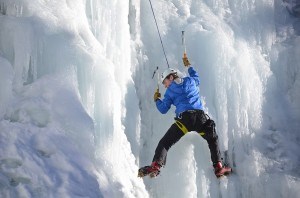
If you’re a Parks Canada visitor safety technician, how do you stay in shape to meet the demands of a winter rescue operation? Ask Rupert Wedgwood, and the answer is to follow a strict training regimen of climbing on the gnarly ice walls of Jasper National Park.
Think of an ice climber as a triple threat—the strength of a weight lifter, the dexterity of a gymnast and the perseverance of a long distance runner. These are the same skills and qualities our visitor safety technicians hone as they train to prepare for rescue operations in the park.
“Ice climbing is a demanding activity where all of your body and mind are engaged,” says Rupert Wedgwood, visitor safety manager at Jasper National Park. “Every winter season, our team takes to the park to sharpen their teamwork skills and become better prepared for any challenging situation they might encounter.”
Now, if you think ice climbing is an activity only for those at the peak of their physical fitness and with nerves of steel, think again. The combination of easy access, reliable conditions, hundreds of route options, and a long climbing season have secured Jasper National Park and the Canadian Rockies a reputation as a premier ice climbing destination for all skill levels.
Every type of ice climb can be found here, from long alpine ice routes to short bolted mixes and dry tooling routes—all against the spectacular backdrop of a national park. For the eager novice, the easily accessible Maligne Canyon can be explored with an experienced guiding outfit. For the seasoned aficionado, the complex Polar Circus or Weeping Wall can help refine your technique and reach your ultimate goal.
When planning your ice climbing adventure, keep in mind that some ice climbing routes will form in October, but the best conditions will be from December to March. The earliest ice climbs form at higher elevations on north and north-easterly facing slopes. Many of these can be found in the Columbia Icefields area, and are often considered alpine ice routes. By mid-March, many of the lower elevation ice climbs start to melt and by mid-April, only a few climbs remain.
The tools of the trade—crampons, ice axes and screws—are a must when it comes to getting a solid grip on the ice. Protective gear such as a helmet, clothing and gloves help keep the cold at bay.
“While ice climbers and alpinists are typically a well prepared group, they cannot take anything for granted as they mount their frozen challenges. Safety remains a priority in this unpredictable environment,” reminds Wedgwood.
The recent elevated avalanche risk means all backcountry users should be equipped with essential safety gear for avalanche terrain. It is recommended that all members of the party carry an avalanche transceiver, a probe, and a shovel, regardless of expected conditions. It is equally vital that everyone is familiar with and has practiced using this equipment.
Parks Canada provides daily Avalanche Bulletins at www.avalanche.pc.gc.ca to assist backcountry users in decision making. The bulletins contain timely and detailed information on current avalanche conditions and a three-day forecast.
Check the road report for the most recent information on planned closures and expected opening times before heading out: www.511.alberta.ca or 780-852-3311.
“In my 25 years of exploring and training in our national parks, the rewards of ice climbing have been limitless,” says Wedgwood. “From connecting with nature to achieving personal performance goals, get outdoors and test your mettle on the ice this season!”
Parks Canada
Special to the Fitzhugh
